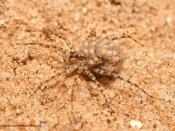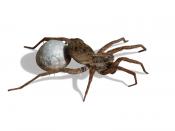Adaptation Project.
The arthropods constitute over 90% of the animal kingdom and are classified in the phylum Arthropoda.: There are more arthropods than any other group of invertebrates. And, considering that 95 percent of all animals are invertebrates, that makes arthropods truly the must abundant group. This is how the whole group is classified:
* an exoskeleton (a skeleton on the outside of the body)
* body divided into distinct parts
* jointed legs and appendages
* bilateral symmetry (both sides of the body are the same)
I will focusing on the arthropod: Arachnid.
Arachnids
There are many different types, varying from Spiders, scorpions, ticks, mites, etc. 65,000 described world species
* two body regions: cephalothorax, abdomen
* eight legs
* no antennae
* Mouth parts are chelicerae(modified appendages) which in spiders are fangs.
Spiders are ancient animals with a history going back many millions of years. They have always been with us, an ancient source of fear and fascination.
They are abundant and widespread and are natural controllers of insect populations. Wherever you live, you're always close to a spider.
Mating behaviour.
Mating organs in closely related species often have very distinctive structural differences, which, along with behavioural and chemical recognition cues, have evolved to prevent unproductive attempts at cross-breeding between species. In many cases the structure of the mating organs in mature spiders is the most important means we have of separating closely related species. Until they mature, it is almost impossible to reliably identify spiders to a particular species.
A male Orb Weaver (Eriophora) plucks at his mating line and entices a female onto it. Photo: M Gray Australian Museum
Egg sacs and maternal care
AustralianThe egg sac silk protects the eggs against physical damage and excessive drying, wetting or heating, as well as providing a...



Overall a good essay
Overall it is a good essay, but the information is a little messed up.
1 out of 1 people found this comment useful.